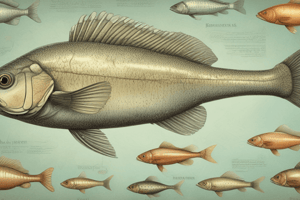Podcast
Questions and Answers
What is the primary aim of biological classification?
What is the primary aim of biological classification?
- To group organisms based on shared characteristics (correct)
- To create a visual representation of organisms
- To provide a detailed account of all known species
- To study the physiology of individual organisms
Which historical classification system had the most significant influence on modern taxonomy?
Which historical classification system had the most significant influence on modern taxonomy?
- Linnaeus's binomial nomenclature (correct)
- Aristotle's hierarchical system
- Lamarck's theory of inheritance
- Darwin's natural selection framework
In modern classification, which of the following is NOT typically used to determine evolutionary relationships?
In modern classification, which of the following is NOT typically used to determine evolutionary relationships?
- Superficial appearance (correct)
- Fossil records
- Molecular biology
- Geographical distribution
What is the correct order of the Linnaean hierarchy from broadest to most specific?
What is the correct order of the Linnaean hierarchy from broadest to most specific?
Which domains of life comprise only prokaryotic organisms?
Which domains of life comprise only prokaryotic organisms?
Which of the following is accurately classified in the Linnaean system?
Which of the following is accurately classified in the Linnaean system?
How does biological classification aid scientists in their research?
How does biological classification aid scientists in their research?
What is a characteristic of eukaryotic organisms?
What is a characteristic of eukaryotic organisms?
Flashcards
Biological Classification
Biological Classification
The process of grouping organisms based on shared characteristics and evolutionary relationships.
Linnaean System
Linnaean System
A scientific system for naming and classifying organisms, based on observable physical traits. It uses a two-part name: genus and species.
Phylogenetic Tree
Phylogenetic Tree
A diagram that shows the evolutionary history and branching relationships between species.
Domain
Domain
Signup and view all the flashcards
Prokaryotes
Prokaryotes
Signup and view all the flashcards
Eukaryotes
Eukaryotes
Signup and view all the flashcards
Species
Species
Signup and view all the flashcards
Binomial Nomenclature
Binomial Nomenclature
Signup and view all the flashcards
Study Notes
Introduction to Biological Classification
- Biological classification is the process of grouping organisms based on shared characteristics and evolutionary relationships.
- It aims to organize the diversity of life in a systematic and hierarchical manner.
- Classification systems help scientists study, understand, and predict the properties of organisms.
Historical Classification Systems
- Early classification systems were often based on superficial characteristics, like appearance.
- Aristotle's system, while rudimentary, was influential for its hierarchical structure.
- Carl Linnaeus developed a more sophisticated system based on observable physical traits, using binomial nomenclature (genus and species).
- This system remains the basis of modern taxonomy and is foundational to the study of biological diversity.
Modern Classification
- Modern classification relies heavily on evolutionary relationships, using phylogenetic trees.
- Phylogenies show the evolutionary history and branching relationships between species.
- Evidence used to determine relationships includes morphology, anatomy, physiology, genetics (DNA and protein sequences), and fossil records.
- Modern classification strives to reflect the evolutionary history of organisms, thus emphasizing phylogenetics.
Linnaean Hierarchy
- The Linnaean system provides a hierarchical framework, grouping organisms into increasingly inclusive categories.
- Starting from broadest to most specific, these categories are Kingdom, Phylum, Class, Order, Family, Genus, and Species.
Domains of Life
- Three domains currently classify all life: Bacteria, Archaea, and Eukarya.
- Bacteria and Archaea are prokaryotic; lacking a membrane-bound nucleus and other organelles.
- Eukarya encompasses organisms with a nucleus and membrane-bound organelles, including protists, fungi, plants, and animals.
Classification of a Sample Organism: Human
- Kingdom: Animalia
- Phylum: Chordata
- Class: Mammalia
- Order: Primates
- Family: Hominidae
- Genus: Homo
- Species: sapiens
Importance of Biological Classification
- Enables efficient organization and identification of organisms.
- Helps scientists understand evolutionary relationships and patterns of diversification.
- Forms a basis for research in fields such as medicine, agriculture, and conservation.
- Allows for the identification of newly discovered species, clarifying their relationships to existing species.
- Provides a framework for analyzing biodiversity at all levels, promoting better conservation strategies.
Challenges in Modern Classification
- Classifying organisms based on DNA sometimes presents conflicting evidence when compared with anatomical features.
- Determining evolutionary relationships between groups can be complex and debated, especially for groups with incomplete fossil records or ambiguous genetic data.
- New discoveries and research frequently lead to revisions and updates in classification systems.
- Maintaining consistency and universality across global classification efforts requires ongoing and collaborative development.
Studying That Suits You
Use AI to generate personalized quizzes and flashcards to suit your learning preferences.




